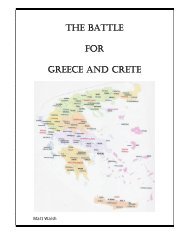Memorial Walk CBD Secondary teacher resource.pdf
Memorial Walk CBD Secondary teacher resource.pdf
Memorial Walk CBD Secondary teacher resource.pdf
You also want an ePaper? Increase the reach of your titles
YUMPU automatically turns print PDFs into web optimized ePapers that Google loves.
8 AUSTRALIAN LIGHT HORSE<br />
and WAR HORSE MEMORIALS<br />
Background Information<br />
Time to allow: 10 minutes<br />
This site contains three memorials, the Australian Light Horse <strong>Memorial</strong>, the War Horse<br />
<strong>Memorial</strong> and the Royal Australian Armoured Corps <strong>Memorial</strong>.<br />
The Light Horse <strong>Memorial</strong> is dedicated to the honour and glory of those Light Horsemen<br />
who died in battle during the First World War. The Australian Light Horse were involved in<br />
many famous battles during the First World War including the heroic bayonet charge at the<br />
‘Nek’, Gallipoli (17 August 1915) and the famous cavalry charge at Beersheba, Palestine (31<br />
October 1917) which was the last time horses were used as cavalry by Australian forces.<br />
The War Horse <strong>Memorial</strong> commemorates the services of Australian horses that took part in<br />
the Great War. At the end of World War I the horses used by the Australian Light Horse<br />
could not return home. Due to quarantine regulations it was impossible to take tens of<br />
thousands of army horses back to Australia. Many horsemen preferred to shoot their mounts<br />
rather than risk the chance of them being ill treated.<br />
The Royal Australian Armoured Corps <strong>Memorial</strong> is dedicated to the service of those<br />
members of the RAAC, who were the successors to the Light Horse regiments and served in<br />
World War II 1939-45. Horses were replaced in the Armoured Corps during the Second<br />
World War by motorised machine gunners, armoured cars and light and medium tank<br />
regiments.<br />
Student questions<br />
WAR HORSE MEMORIAL<br />
(1) Comment on the shape of the memorial. Hint: What is it?<br />
It is in the shape of a water trough for horses which is the purpose for which it was<br />
originally used when it was located in Victoria Square. The State Government<br />
provided free water at the time to enable horses to drink from the trough.<br />
(2) What does this monument suggest to you about the contribution of horses in<br />
World War I?<br />
The monument pays tribute to all horses used during World War I. Horses played<br />
many roles during World War I and were an important part of the war effort. Their<br />
roles included use as cavalry in the Charge at Beersheba, transporting troops and<br />
carting of loads, pulling large guns and horse ambulances during World War I.<br />
18











